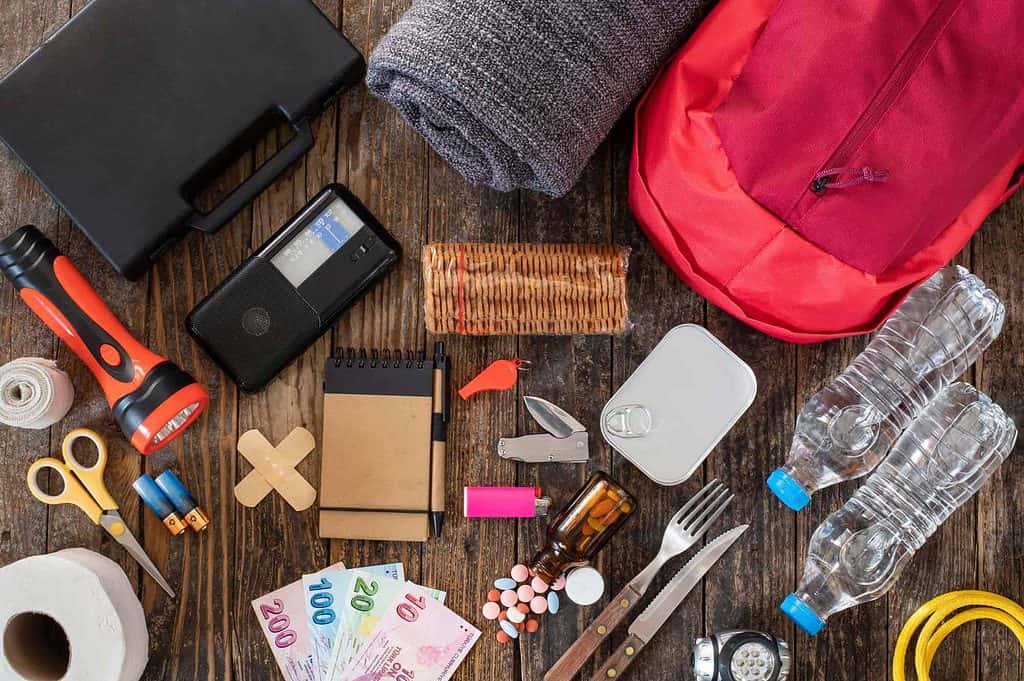Last Updated on February 22, 2023
I originally wrote this blog the week following the February 22, 2011 Christchurch earthquake. It was 11 days out from ‘quake day’, and we didn’t have power, running water or sewerage. Many people can’t begin to imagine what that must be like – and I was one of them. Back in the September 2010 earthquake, power and water were restored for us quite quickly (other suburbs were not so fortunate). But now I know what it’s like, so here’s some advice I’ve learned from my experience of 3 large quakes and thousands of aftershocks of various sizes.
I wrote this blog largely to warn my Wellington-based family members (who conceded after reading my advice that they were not as prepared as they thought they were).
The purpose of this article is to provide you with some tips and ideas about being ready for an earthquake or for any natural disaster. I can’t really cover all the situations as things could be very different based on where you are and how badly damaged your house is. Our house was fortunately liveable – but a real mess.
Please visit the Get Through website for official advice on what to do during an earthquake.
During the shaking and immediately after, my advice is to keep as calm as possible. Once the shaking stops (if you are in a safe place), take the time to consider your next move. Our retaining wall had collapsed and looked like it could go further, I stopped and thought about the consequences of climbing over it versus staying in the house. Your survival instincts will kick in, and you will hopefully do what is right for you in the circumstances (that’s why you need to stay calm).
Have a ‘go bag’
You should be prepared to ‘pick up and go’ as that was my first instinct (I was at home alone when the earthquake hit). The house was a mess, and I didn’t know if it was safe due to the retaining wall partially collapsing. All I wanted to do was pick up a backpack and get out of the house.
So as part of my being ready advice, I highly recommend a backpack full of the things you will need. Keep it somewhere accessible but not in the way (hard to do, I know). The thing about survival kits is that we often store them in the garage or hard to reach places, making them very difficult to get to – especially if everything has been knocked about and off shelves due to the quake.
So, here’s what I recommend you put in your pick up and go kit – you will probably think of lots of other things that will suit your circumstances.
Things to have in your ‘go bag’ in no particular order:

- A torch that takes AA batteries. Most people have AA batteries around the house, and they are easy to store. Most people don’t regularly buy D or C batteries.
- Spare AA batteries.
- Wind-up radio that has a torch. This is one of the things I left the house with, and when I met up with a group of neighbours in the park (about 8 of us) it was the only source of information we had about what was happening.
- Several 1.25-litre bottles of water. Each 1 litre of water weighs about 1 kilo. So think about how much you can carry and lift. We had a 20-litre container of water stored that I could barely lift, and it was very difficult for me to tip it over to fill smaller containers without spilling some water. By all means, have large containers of water stored, but have lots of small ones. This is especially important for women – it’s very frustrating trying to do everyday tasks when your water is so darn heavy.
- Funnel – for transferring water from large containers to small containers.
- Sturdy footwear – I was wearing high heels during the quake, a real nuisance for climbing over stuff all over the floors. So get a cheap pair of sneakers or use an old pair you don’t wear anymore.
- Toilet paper – you don’t know when (or where) you will need to go next.
- Wet wipes or baby wipes. These are very useful for washing hands and face, and if you wet them a little with some soap, you can have a bit of a wash. And trust me, after four days or more without a shower, a baby wipe will seem like a luxury.
- Mirror
- Swiss Army Knife
- Cash – however much you can afford to have sitting in a bag
- Hand sanitiser – essential if you don’t have water or you don’t want to use the water you do have. I used a combination of baby wipes and hand sanitiser to clean my hands.
- Barley sugars or boiled lollies (sweets, candies). I had a couple, and they helped calm me down a little, got rid of the dry mouth feeling I had, and gave me a little bit of an energy boost.
- Mini toothbrush and paste kit – you will be amazed at how little things like brushing your teeth will make you feel better.
- Mouth wash – good for just swirling around the mouth to beat ‘earthquake breath’, and you can brush your teeth with it to save on bottled water (though I don’t recommend strongly minted ones).
- Emergency blanket – the small square metallic-looking blankets you can get from camping/hiking stores.
- Small gas cooker and gas canister (the type you would use if you went tramping/hiking)
- Waterproof matches
- Candles (though these can be dangerous if you get aftershocks)
- Energy bars (ones that last a while and have a high-calorie content) – something like http://www.onesquaremeal.co.nz
- Painkillers – Nurofen (ibuprofen) or Panadol – you will forget to drink or eat, get dehydrated and tired, and develop a thumping headache. And when you are in a difficult situation, you want to think clearly.
- Change of clothes. Have three layers of mohair clothing. Mohair breathes, and you can wear it for days without it smelling (trust me on this one!). A cheap rain jacket that will keep you dry (such as a PVC rain jacket – OK, so it’s not high fashion, but the goal here is to keep you dry – the mohair will keep you warm).
- Spare prescription glasses (your old glasses are better than no glasses).
- Contact lens case and solution.
- First aid kit
- SD card with your most precious photos digitised onto them and scans of your important documents (proof of your address, birth certificate, driver’s licence, passport) and photocopies of the same documents in a water tight plastic bag.
- Your medications and prescription scripts
- Plastic bags – these can be put to lots of different uses
- Car power inverter – you stick it into your cigarette lightener in the car and get power from the battery to run items like a laptop or charge a cell phone
- Spare cell phone charger
- A cheap pre-paid cell phone that uses a different carrier from your usual one – OR it’s really helpful if your significant other uses a different carrier
- Tea, coffee, sugar
- Powdered milk
What to have on hand in the house
Being well prepared generally and making it a part of your life will make things better for you when the worst happens. Do not eat the food if you have a separate emergency food kit! And remember, there is no such thing as ‘emergency chocolate’ you know it won’t be there in an emergency. We didn’t have an emergency food kit, but we always have probably about a week’s worth of food in the house anyway.
Have:
- Lots of canned food such as baked beans, spaghetti, tins of fruit in natural fruit juice
- Tin opener
- Duct tape
- Swiss Army Knife
- Milk powder or UHT (ultra heat-treated) milk
- FM / AM radio that uses AA batteries and or a wind-up radio (though the wind-up radio can be annoying to wind constantly).
- Rice and pasta
- Dehydrated vegetables
- Dehydrated meals (the type you can get from a camping store)
- Gas cooker (one burner is OK, but several are better) and gas canisters
- Gas barbecue (many Cantabrians simply barbecued every night)
- Plastic picnic set – as your crockery and glassware may all be smashed, and what’s left will be covered in glass, dust and whatever has fallen out of your pantry or fridge
- Lots of water stored – they recommend three days’ worth of water and 3 litres per person – have a mixture of small and large containers
- Thick rubber gloves for the cleanup
- Large thick plastic rubbish bags (can be used to line the toilet)
- Broom, hath brush and shovel for sweeping up glass
- Detergent for cleaning down surfaces
- Bleach for cleaning surfaces and the plain bleach can be used to disinfect drinking water (1/2 a teaspoon of bleach to 10 litres of water – let it sit for 30 minutes)
Dealing with the emotional aftermath
You’ll feel adrenaline, excitement, fear, stress, anxiety, frustration, and anger simultaneously. You may find that you deal remarkably well after the first few weeks – as your energy is being put into the day to day living. Once things start to get back to some kind of normal, you may find that is when you start to experience some physical symptoms of the stress you have been under. You may get sick or begin to suffer from anxiety or depression. The tiniest thing may set you off, and there may be tension in your immediate family situation or with colleagues in your workplace. Remember it is not them, and it’s not you at fault, it’s the situation you find yourself in, so be kind to each other and give each other a break. Under normal circumstances, the behaviour you may expect from your loved ones is not what you will get after weeks of built-up stress and worry. Try to find ways to see the funny side of what you are experiencing – humour is a great stress reliever. Be kind to yourself – eat well, exercise and don’t overindulge (though it’s hard not to reach for the chocolate, wine glass or ice cream).
Well, I hope this helps you in some small way. And I sincerely hope you never have to go through what Christchurch has experienced.

